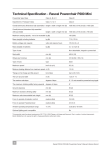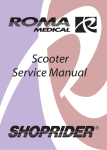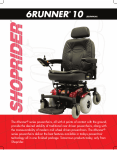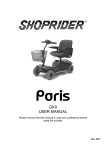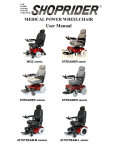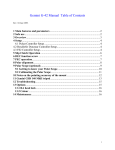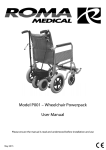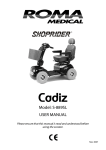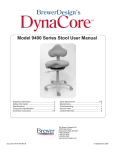Download Powerchair Service Manual Live Document
Transcript
Powerchair Service Manual Index 1. Safety advice. 2. Warranty Information. 3. Tools required. 4. Product identification. 5. Seat removal and adjustments. 6. Body panel removal. 7. Battery and battery charging information. 8. Battery removal and testing. 9. Brake removal and testing. 10. Motor brush removal and checks. 11. Transaxle Assembly. 12. Wheels and tyres. 13. General checks and tips. 14. Controller errors and diagnostic guide. 15. Annual Inspection Checks 16. Wiring diagrams. 2 1. Safety Advice Always observe a safe working practice. Powerchairs and their component parts such as batteries and subassemblies can be very heavy so care must be taken when lifting and carrying/moving. Always seek the assistance of a colleague or use suitable lifting equipment wherever possible. Be aware of where component parts are placed when dismantling a powerchair. Do not leave parts in walkways or in places where they may fall and cause injury (edge of a bench etc.). Never attempt maintenance or repair if the powerchair is connected to the mains power supply. Also disconnect the batteries to prevent any unexpected movement that could result in injury. 3 2. Warranty Information This is the text from the rear cover of the user manuals: “This is to certify that your Roma Medical/Shoprider® product is warranted for a period of 12 months from the date of original purchase. This warranty is not transferable. Should a defect or operating fault arise within this period the Dealer from where the product was originally purchased should be notified immediately. Failure to register the fault may invalidate the warranty. Roma Medical warrants that if a fault occurs within this period due to faulty workmanship or materials that the product will be repaired (or replaced at the Company’s discretion) free of charge. Any unauthorised modifications will invalidate the warranty. Parts which are subjected to normal wear and tear, accidental damage, neglect or misuse are excluded from this warranty. Normal wear and tear includes tyres, chassis covers, bulbs, seat coverings etc. Component parts replaced outside this period carry a six-month warranty. (Standard terms and conditions apply for this period).” Please note: Battery warranties MUST be accompanied by a valid test certificate. A multimeter reading will not be sufficient to determine a batterys performance. 4 3. Tools Required The following list is a guide to what tools are required to comfortably maintain powered powerchairs. • • • • • • • • • • • • • • • • Multimeter Set of metric allen keys Socket set (metric) Set of open end spanners from 3mm to 15mm Magnetic tipped screwdriver set Bondlock B270 / B220 thread locking compound Torque wrench – up to 25Nm rated Wire stripper Crimp tool and crimps Mole grips Rubber mallet Stanley knife Circlip pliers Pliers (long nose and combination) Tyre pump and pressure gauge Tape measure and metal rule Recommended Stock Spares Roma Medical carries a comprehensive stock of spare parts it is recommended that certain parts should be to hand, these would include:Motor Brushes Blade Fuses Various Nyloc Nuts and Washers (always replace nyloc nuts for new) 5 4. Product Identification Each powerchair will have a unique serial number allowing it to be traced to its original date of sale and the serial numbers of the original motor, gearbox, brake and controller. The powerchair will also have a product ID that is located on a label on the rear chassis frame. Alternatively, if you have the model name; this can be crossreferenced to the product ID. Product ID S888WA S888W S888WS SUL7 SUL8 S888WNLS S888WNLM S888WNLL Product Name Verona Nippy Snappy Vienna Venice Sena Malaga Lugano Please see image below for an example of the serial number label. Always refer to the serial number and product ID when ordering spare parts or contacting the Roma Medical technical staff. 6 5. Seat Removal NOTE: Always disconnect the joystick control before attempting to remove the seat. Failure to do so could damage the loom or controller. Before undertaking maintenance or repair work on the powerchair, you will have to remove the chassis cover, which will involve the removal of the seat. Models 888W, WS & WA have handknobs underneath the seat. Undo the handknobs and simply lift the seat away from the chassis. Models 888WNLS/M/L have release levers under the seat, which enable the seat to be lifted forward to gain access to the running gear, batteries and looms. Unplug the controller and remove the armpad by undoing the arm height adjustment handknob, place this carefully to avoid damage. Release the two rear yellow levers and lift the seat forwards and over. Place a protective sheet on the floor to protect the seat. The Sena and Malaga chassis covers can be removed. The rear seat struts must be removed on the Lugano by removing the locking pins before the chassis cover can be removed. Please see images on following page. Caution should be taken when lifting the larger type captain seats (20kgs). 7 8 6. Body Panel Removal It will be necessary to remove the chassis cover to gain access to the electrical connections, batteries and drive units of the powerchair. (except the UL7 Vienna model) Powerchairs generally have just one chassis cover which is secured with Velcro strips. To remove the cover you should first remove the seat as described previously. The UL8 Vienna has a front and rear cover. The powerchair must be disassembled as per user manual before removing the rear cover. Ensure all handknobs and seat post pins are removed and put in a safe place. Carefully lift the chassis cover away from the powerchair and place on cardboard or other protective surface. 9 7. Battery And Battery Charging Information Each powerchair is fitted with two 12 volt sealed, maintenance free gel or AGM (absorbent glass mat) batteries*. These are connected in series to provide the 24-volt operating voltage. Batteries (if faulty) will normally fail within the first three months of use, after this period it is normally incorrect maintenance or charging procedure which will lead to failure. Product ID S888WA S888W S888WS SUL7 SUL8 S888WNLS S888WNLM S888WNLL Product Name Verona Nippy Snappy Vienna Venice Sena Malaga Lugano Battery Capacity (Ah) 34/36 38/40 34/36 21 12 (Lithium Based)* 21 34/36 73/75 Charging Each powerchair is supplied with a charger# – this may be either a switch mode type or transformer type. The switch mode charger will automatically stop charging when the cycle is complete. The transformer type will revert to a ‘trickle’ charge mode when the cycle is complete. Charging status will be indicated by LEDs on the charger. Red indicates a disconnection, flashing green or amber indicates charging and a continuous green LED indicates the charging cycle is complete. Avoid interrupting the charge cycle as this may damage the batteries. # The Sena and Verona powerchairs are fitted with on board chargers. They may still be charged via the socket on the joystick controller. 10 8. Battery Removal and Fitting. Should a problem occur which would indicate a battery fault; each battery should be tested to find the faulty cell. Industry standard devices such as the Alpha Bat tester can be used to give a percentage of the battery’s true capacity rating. ALWAYS charge the powerchair fully before undertaking any battery tests. Note: DO NOT attempt to test the UL8 Venice battery pack using devices designed for 12v batteries – it is not two 12v cells but a complete 24v system and cannot be tested using these products. DO NOT use devices that are designed for use with automotive type batteries. These are not designed to test deep cycle batteries used with powerchairs and can cause permanent damage to a battery. A simple test to indicate a possibly failed battery is to run the powerchair under load and take a voltage reading of each battery with a multimeter. To do this, remove the shroud covering the batteries and connect the multimeter to one of the batteries. Re-fit the seat and drive the powerchair a small distance. The battery voltage should not fall lower than about 11 volts. Repeat the test for each battery. Overall system power can be tested via the charge socket on the joystick controller with a multimeter. Carefully place the multimeter probes in the corresponding sockets as shown in the image. A fully charged powerchair should give a reading between 25 & 26 volts. 11 Battery Fitting When delivered new (Malaga & Lugano) or fitting replacments, it is essential that the batteries are fitted correctly to avoid causing permanent damage to cables and electronics. Wires are colour coded and clearly identified for positive (+) and negative (-) polarities. Each powerchair will have a negative and positive battery cable. These can be identified by the location of the fuse holder on the cable. If the holder is located on the negative (black) wire then it can be identified as a negative battery cable. Always ensure that battery terminal connections are secure and clean. Please order the correct cable when replacing. 12 9. Brake Removal And Testing Old Type New Type The electromagnetic brake is located on the end of the motor and can be removed by undoing the three screws. When 24v is applied, the brake will release allowing the powerchair to drive (this can be heard by an audible ‘click’). If the powerchair fails to move there may be a problem with the joystick controller or the brake itself may be faulty. Use a multimeter to determine if 24v is reaching the brake when the throttle is applied. If there is 24v measured at the plug and the brake fails to operate the brake is either faulty or possibly stuck. It is easier to diagnose brake faults when the brake is removed from the motor as you can see the internal mechanism physically release and lock. A brake may stick if the powerchair has not been used for a prolonged period of time. If power is reaching the brake but it does not release check to see if there is any corrosion inside the end of the brake (by the plate with the hexagonal hole). If necessary, use a release agent such as WD40 to lubricate the brake and re-apply power to try and release the brake. If the brake is releasing you will be able to move the internal plate with the hexagonal cutout when power is applied. The brake should show continuity when tested with a multimeter – if this is not the case, replace the brake. 13 10. Motor Brush Removal And Checks Each motor has a pair of carbon brushes. Depending on the model, the brushes will be accessible by removing brush caps (Type 1) or by removing the brake from the motor and removing the back plate from within the motor (Type 2). Type 2 Type 1 When new, the carbon brushes will be approximately 15mm long. Care should be taken when re-fitting the brush caps – gently tighten until the cap securely locates, do not over tighten as this can cause the brush cap to break. When changing the brushes it is a good idea to make sure the commutator contacts are clean. Look down the brush housing to see for any visible signs of dust/debris. If necessary clean out the motor with compressed air or electrical contact cleaning spray. DO NOT use any form of lubricating oil to clean the motor internals. If changing brushes, always change the pair to ensure even wear. 14 11. Transaxle Assembly The transaxle / drivetrain consists of three main components which are the brake, motor and gearbox. These are connected in the order as shown in the diagram below. There are a further two components which are located between the interfaces of the three main components to ensure functionality of the full assembly. It is critical that the interface components (hex nut & drive coupling) are present during the re-assembly of the unit. Please note that the hex nut is secured on the motor shaft with two grub screws. Failure to secure the hex nut to the drive shaft will cause the brake to be in-effective. 15 12. Wheels & Tyres The smaller powerchairs will be fitted with one-piece plastic rims and solid tyres, the larger powerchairs have split aluminium rims and either pneumatic or infill tyres. Whenever replacing tyres or inner tubes it is essential that the tyres are completely deflated before attempting any replacement. Above is the breakdown of a typical wheel assembly which consists of an inner and outer rim; these are held together by four bolts. The wheel is mounted using a central 8mm bolt which should be tightened to 15Nm torque. Always use a thread locking compound to the specification previously mentioned when re-assembling the wheel and on the main axle bolts when re-fitting the wheel to the powerchair. The chart below shows the manufacturers recommended tyre pressure for different sized wheels. Tyre pressure may be reduced by 3 psi. to give a smoother ride over small bumps. Wheel Size 2.80 x 2.50 [8 inch] 260 x 85 [10 inch] 330 x 100 [13 inch] Tyre Pressure (psi) Min. Max 25. 25. 25 22 22 22 25 25 25 16 13. General Checks And Tips Examine the motor, if it has a microswitch to indicate freewheel engagement, check the operation of the switch using the continuity mode on a multimeter. If the switch does not open or close in either lever position replace the switch. Checklist The most common problem with the powerchairs is in the BATTERIES. Load testing batteries is a good first step in troubleshooting powerchair problems. Also check the battery cables for secure terminal connection. Batteries are guaranteed for 1 year but from experience and dependent on the user this time can be considerably extended. Faults that occur with batteries will appear in the first 3 months of use, later than this normally is due to misuse. Put the powerchair on blocks to get the rear wheels clear of the ground. Measure motor voltage at the white 4-pin connector going to the motor. (The thicker wires are the motor wires). This should measure 0 volts when you first turn on powerchair. Push the joystick to increase the speed, this will increase to a maximum of 24 Volts. Measure brake voltage at the white 2-pin connectors going to the brakes. This should measure 0 volts when the brake is engaged (either with powerchair powered on or off). Once you engage the throttle, the brake voltage should increase to 24 volts, thus releasing the brake. (If less than 24 volts is going to the brake, the brake may only be partially releasing.) 17 Continued… Intermittent problems are usually caused by faulty wiring. Check all connections and run a continuity test on the wiring looms. If, after thoroughly troubleshooting the powerchair, you have any further questions, please call the Shoprider service department and we will be glad to assist you. For warranty replacement, have the Model Number, Serial number of the powerchair and the part, and purchase date of the powerchair ready. We will arrange for our Returns Form to be sent with the warranty replacement parts. Please check the following also when examining a powerchair which appears to be faulty:Circuit breakers Battery fuses All loom connections Motor brushes and brush caps Battery voltages Please see below for the required settings that you will need when using the multimeter. 18 14. Controller Errors and Diagnostic Guide Powerchairs have a self-diagnosis feature which is programmed into the joystick controllers. This enables most errors to be quickly identified and corrected (see chapter 13). Should you find that the controller does not show any error, you have to establish at what point power ceases. • Check battery voltages with a multimeter. • Check the battery terminal connections and fuses on the battery leads. • Check the circuit breaker has not ‘popped’. • Check loom connections – especially where the joystick controller connects to the main loom. When disassembling people will sometimes pull the cable to disconnect the controller instead of pulling the plug, which can lead to damaged connections. • Check voltage at charge socket. (see battery removal) Should all the above checks not identify a fault, it is likely that the joystick controller is faulty. If possible test with a replacement to confirm. Do not use joysticks from different models to affect a permanent repair, as each joystick is programmed to the specific model it is used on. Roma Medical does not repair joysticks. For repair contact the manufacturers’ customer services department directly. PG Drives Technology 10 Airspeed Road Christchurch Dorset BH23 4HD Dynamic Europe Ltd Stonebridge Cross Business Park Droitwich Worcestershire WR9 0LW Tel: 01425 271444 Fax: 01425 272655 Tel: 01905 772321 Fax: 01905 827520 19 Continued… There are two main types of joystick controls used, these are the Penny & Giles ‘VSI’ type and the Controls Dynamic ‘DL’ type. The controllers have the ability to determine errors and faults on the powerchair. These are displayed on the battery gauge (part A in the images). The VSI will flash a number of leds to show the error code, the DL will flash all leds a number of times to indicate the fault. Part B on the VSI indicates the maximum speed setting, should you experience this part of the display oscillating to and fro, it indicates that the VSI has been locked. Please refer to ‘VSI Lock Function’ to understand the locking / unlocking procedure. DL VSI Penny & Giles VSI Controller Battery Gauge Possible Fault 10 bars flash Battery voltage too high. connections. 9 bars flash Electromagnetic brake fault 8 bars flash Possible joystick controller fault 7 bars flash Possible joystick fault 6 bars flash Battery charger connected 5 bars flash Right hand motor wiring fault 4 bars flash Right hand motor disconnected 3 bars flash Left hand motor wiring fault 2 bars flash Left hand motor disconnected 1 bar flashing Low battery voltage 20 Check battery Continued… Dynamic DL Controller Flash Code 1 2 3 4 5 6 7 Fault Type Suggested Actions Low Battery Fault Voltage Check battery voltage is above 17v. Check battery connections and terminals. Check condition of batteries. High Voltage Fault Check battery voltage is below 32v. Check battery wiring and terminating is secure. Left Motor Fault Check left motor, connections and cables. Right Motor Fault Check right motor, connections and cables. Park Brake Fault Check the brakes, connection and cables Controller Fault Contact Service Agent. Note: In some cases a motor fault that occurs when driving may cause a 6 flash fault to be registered. Motor Stalled or Ensure joystick is released at power up. Joystick Out of neutral Ensure motors are free to turn and power off at power up. and on. VSI ‘Lock’ Function* Your VSI controller is equipped with a lock function to prevent any unauthorised use. To lock the controller: • When the power is on, press and hold the power button for about 1 second until the system bleeps. • Move the joystick forward until it bleeps, then move it to the back position until you hear a bleep. • Release the joystick – you should now hear a long bleep, this indicates the system is now locked. To unlock the controller: • Press the power button until the speed indicator lights go from left to right. • Move the joystick forward until it bleeps, then move it to the back position until you hear a bleep. Release the joystick – you should hear another bleep, this indicates that the system is unlocked and ready for use. *VSI controllers can be re-programmed using a PP1 unit which can enable/disable this function. 21 Continued… VSI Run Timer The VSI joystick has an in-built timing function which measures the actual run time of the powerchair. The time is the actual running time and NOT the time that the unit has been switched on. To access the information you will require a PP1 (image below) hand held programmer (available from PG Drives Technology). Simply plug the programmer into the charge socket and switch the unit on. Use the keypad to scroll to the “Read Timer” option and press enter “↵”. The run time in hours will be displayed on the screen. 22 15. Annual Inspection Checks As part of the powerchair’s annual inspection, the following checks should be undertaken to ensure safe and reliable operation. Drive System Ensure the powerchair runs in a straight line and does not veer to one side during driving. Should it veer to one side, check tyre pressures where pneumatic tyres are fitted. Also check the carbon motor brushes are not overly worn. As a reference, a new motor brush is approximately 15mm long. Check for any lubricant leaks from the gearbox. Electromagnetic Brake Function When driving, release the joystick to allow the brakes to operate. The powerchair should stop in less than 60cm. Should the distance be greater, the joystick may be programmed to reduce or increase the stopping distance using the correct programmer. NOTE: Only attempt re-programming if you are familiar with the users requirements and programmer – failure to do so could result in injury to the user. 23 Continued… Frame / Chassis Inspection Check all areas for deformation or cracked welds, paying particular attention to areas of greatest stress such as seat post brackets, castor mounts and axle pivot points, gearbox/drive train mounting points, armrest and footrest brackets and areas where the chassis can be split for transportation (where applicable). Check bolts ‘E’. These secure the seat to the seat mounting plate. If any are missing refer to the relevant spare parts list for replacements. Parts ‘B’ & ‘D’ are either hand knobs or levers and should be fully tightened and show no signs of free play. 24 Continued… Upholstery Check for any tears, rips, general thinning of padding and any areas where the seat frame may have protruded through the upholstery. Pay particular attention to areas which contact the user, as continued use of a worn seat or backrests which offer little pressure relief could lead to pressure sores with a full time user. Wheels and Tyres Check for any wall damage to pneumatic tyres. Check solid wheels for any embedded objects and remove accordingly. Tyre pressure should be set as previously mentioned. There should be at least 1mm tread depth. General Integrity Check for loose handknobs and bolts pay attention to seat and arm adjustment handknobs – tighten where necessary. Should any thread appear worn, replace. Castors should be checked for secureness. There should be no more than 1mm play over the entire length of the castor stem. An obvious sign of a loose castor or worn bearing is castor ‘flutter’. The castor should be free enough to easily move in all directions. Adjust by either tightening or slackening the castor stem nut which will be located under a plastic / rubber dust cap on the castor socket. (See exploded image below). 25 Continued… Anti-tip castors should be checked for integrity to ensure smooth operation. Check the wheels freely spin and are free from debris and the bolt threads are fully secure in the nyloc nut (parts A). Where a lap belt is fitted, check the mounting points to ensure the bolts / handknob ‘A’ are secure. Check for any wear or damage to the belt and buckle. Should any damage be evident, replace the belt. Adjustment of the lap belt Ensure that the user is sitting back fully into the seat with the pelvis as upright as possible and not leaning to one side. Close the buckle and position the belt so that the hip bones can be felt above the lap belt. Adjust the strap length by pulling on the open end of the belt. As a guide, the belt should be adjusted so that there is sufficient room for two fingers to slide between the user’s body and the belt. (instructions are also fitted to the belt) The lap belt is fitted to the powerchair by two handknobs (“A” below). During service, ensure these are fully tightened. 26 Continued… Charging Function An ‘Easy Checker’ is an industry standard testing device which is an inline device between the charger and powerchair which measures the current and voltage which the batteries accept during the charge cycle. If an ‘Easy Checker’ is unavailable a multimeter can be used to confirm that the batteries are receiving charge. Take an initial reading from across both batteries (+ve on one battery to the –ve on the other battery). Begin the charge cycle and take another reading after approximately 15 minutes. This reading should be approximately 26/27 volts. This reading can rise to over 28 volts. Should this not occur, check looms for continuity and try another Shoprider charger of an equivalent output. 27




























